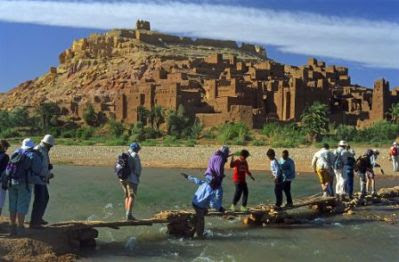Lifestyle in Morocco
Morocco is a developing nation and in many ways can be seen as a culmination of tradition and modernization. For example, it is common in Morocco to see donkeys or horses pulling wagons or goods even in urban areas. At the same time, large cities have cinemas and fashion boutiques. In Morocco a souk is a marketplace. Produce, spice and clothing are sold in stalls often in long alleyways off the city’s main square. Bartering is common in the marketplace as prices are rarely posted.
An upsetting fact is that many Moroccans, especially in rural areas, live in extreme poverty. One in five Moroccans lives below the poverty line. This is mainly because of the harsh terrain in some areas of Morocco. Due to its geography and terrain there is not an ample supply of water in Morocco. Morocco has often faced the hardship of significant droughts.
Most of the water that is available is irrigated for agriculture, leaving a limited supply for use by the people. In rural areas it is common for Moroccans to walk great distances for water.
Typically the poorest people are those who live in rural areas that do not have access to fertile land or irrigation. Many organizations including the World Bank and International Monetary fund have implemented policies to help alleviate this problem. There has been significant progress in reducing poverty in Morocco, but it still remains one of the nation’s greatest challenges.
While many Moroccans reside in cities some Moroccans, mainly in the desert region, are nomadic. Some Berber tribes have a long tradition of moving around the Sahara. As one would expect in the hot temperatures of the Sahara, water is a necessity. There are wells in throughout the desert in Morocco. However, often only the Berber people that reside in the desert know how and where to locate them. Cars, though typically older models, are used to navigate in cities and throughout the country.
Travel
There are several modes of transportation in Morocco. There is a railway system which connects cities in the areas to the north and west of the mountains. The lager cities in Morocco have airports which allow travelers to travel domestically or internationally. Ferries are a typical means of transportation between Spain and Morocco. Livestock are used to transport goods in and around cities and in rural areas.
If one wants to travel from the north to the desert regions in southern Morocco it is common to take a series of taxis. Taxis in Morocco are typically older style Mercedes that travel from one town/city to another. One must change taxis several times if traveling long distances as there are laws prohibiting drivers from going into regions other than the one from which they originate. A taxi driver typically waits in a designated area of the city until he has a full car load, 7 people in most instances. This can get to be quite a hot journey considering the taxi is typically over capacity and most taxis do not have air conditioning. Each passenger pays the driver his share upfront. If a passenger does not want to wait for other passengers to make a ‘full taxi’ he must pay the driver for the empty seats.
As one might expect, camels are the preferred mode of transportation in the Sahara. They have a tremendous capacity to travel long distances in extreme conditions without water. They can carry heavy loads, and are adept to traveling through high winds and heat. Their eyelids have long hairs on the end which allow them to see and navigate even in the Sahara’s infamous sandstorms. Because of their great usefulness in the desert, camels are expensive by Moroccan standards.










































